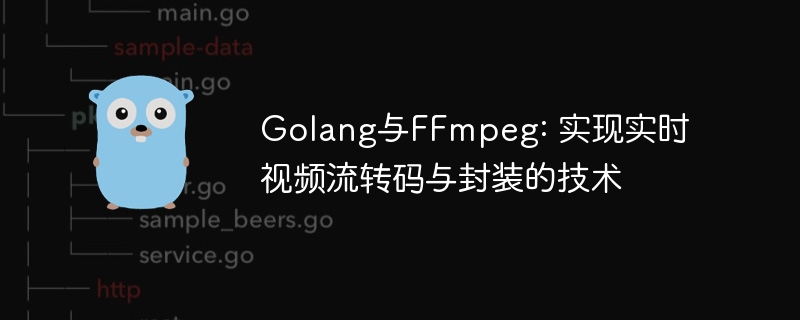Golang与FFmpeg: 实现实时视频流转码与封装的技术
- WBOYWBOYWBOYWBOYWBOYWBOYWBOYWBOYWBOYWBOYWBOYWBOYWB原创
- 2023-09-28 22:30:481351浏览

Golang与FFmpeg: 实现实时视频流转码与封装的技术,需要具体代码示例
概述:
在当今互联网时代,视频已经成为了人们生活中不可或缺的一部分。然而,由于视频格式的不统一以及网络环境的差异,直接在网络进行视频传输往往存在一些问题,如传输速度慢、视频质量下降等。为解决这些问题,我们可以使用视频转码与封装技术,将视频流进行编解码处理,并将其封装成适合网络传输的格式。本文将介绍如何使用Golang与FFmpeg实现实时视频流转码与封装的技术,并给出具体的代码示例。
技术背景:
Golang是一种强大的编程语言,它具有高并发、简洁易用以及快速编译等特点,适合用于网络编程。FFmpeg是一个跨平台的音视频处理工具,能处理几乎所有常见的音视频格式。结合Golang和FFmpeg,我们可以实现高效的视频流转码与封装。
具体实现步骤:
- 引入必要的库
首先,在Golang中引入FFmpeg相关的库。在Golang中,可以使用cgo来调用C语言的库。可以通过go get命令获取FFmpeg的相关库。 - 打开视频输入流
使用FFmpeg的avformat_open_input函数打开视频输入流。该函数需要传入输入流的地址、输入流的封装格式以及其他相关参数。 - 查找视频流信息
使用FFmpeg的avformat_find_stream_info函数来查找输入流的相关信息,如视频流的格式、编码器、帧率等。该函数会填充AVFormatContext结构体的相关信息。 - 打开视频输出流
使用FFmpeg的avformat_alloc_output_context2函数来创建视频输出流的上下文。该函数需要传入输出流的封装格式以及输出文件名。 - 添加视频流信息
将输入流的信息复制到输出流中。 - 打开输出文件
使用FFmpeg的avio_open2函数来打开输出文件。该函数需要传入输出流的上下文、输出文件名以及其他相关参数。 - 编码和封装
循环读取视频流的每一帧数据,然后对帧数据进行编码处理。可以使用FFmpeg的avcodec_encode_video2函数来对视频帧进行编码。编码完成后,使用FFmpeg的av_interleaved_write_frame函数将编码后的数据写入到输出文件中。 - 关闭输入输出流
当视频流遍历完成后,使用FFmpeg的av_write_trailer函数来完成视频的封装。最后,关闭输入输出流,释放资源。
具体代码示例:
package main
// 导入FFmpeg相关的头文件
/*
#cgo LDFLAGS: -lavformat -lavcodec -lavutil
#include <libavformat/avformat.h>
#include <libavcodec/avcodec.h>
*/
import "C"
import (
"fmt"
)
func main() {
// 输入文件名和输出文件名
inputFileName := "input.mp4"
outputFileName := "output.mp4"
// 打开输入文件流
var inputFormatCtx *C.AVFormatContext
if C.avformat_open_input(&inputFormatCtx, C.CString(inputFileName), nil, nil) != 0 {
fmt.Printf("Failed to open input file
")
return
}
// 查找视频流信息
if C.avformat_find_stream_info(inputFormatCtx, nil) < 0 {
fmt.Printf("Failed to find stream information
")
return
}
// 打开输出文件流
var outputFormatCtx *C.AVFormatContext
C.avformat_alloc_output_context2(&outputFormatCtx, nil, nil, C.CString(outputFileName))
if outputFormatCtx == nil {
fmt.Printf("Failed to allocate output format context
")
return
}
// 复制视频流信息到输出流
for i := C.uint(0); i < inputFormatCtx.nb_streams; i++ {
stream := inputFormatCtx.streams[i]
outputStream := C.avformat_new_stream(outputFormatCtx, stream.codec.codec)
if outputStream == nil {
fmt.Printf("Failed to allocate output stream
")
return
}
// 复制流的参数
if C.avcodec_parameters_copy(outputStream.codecpar, stream.codecpar) < 0 {
fmt.Printf("Failed to copy codec parameters
")
return
}
}
// 打开输出文件
if C.avio_open(&outputFormatCtx.pb, C.CString(outputFileName), C.AVIO_FLAG_WRITE) < 0 {
fmt.Printf("Failed to open output file
")
return
}
// 写入文件头部
if C.avformat_write_header(outputFormatCtx, nil) < 0 {
fmt.Printf("Failed to write header
")
return
}
// 读取视频流数据并进行编码处理
packet := C.AVPacket{}
for C.av_read_frame(inputFormatCtx, &packet) == 0 {
stream := inputFormatCtx.streams[packet.stream_index]
outStream := outputFormatCtx.streams[packet.stream_index]
// 编码帧数据
if C.avcodec_send_packet(stream.codec, &packet) < 0 || C.avcodec_receive_packet(stream.codec, &packet) < 0 {
fmt.Printf("Error while encoding
")
return
}
packet.stream_index = outStream.index
packet.pts = C.AV_NOPTS_VALUE
packet.dts = C.AV_NOPTS_VALUE
// 封装编码后的数据
if C.av_interleaved_write_frame(outputFormatCtx, &packet) < 0 {
fmt.Printf("Error while writing frame
")
return
}
C.av_packet_unref(&packet)
}
// 结束封装
C.av_write_trailer(outputFormatCtx)
// 关闭输入输出流
C.avformat_close_input(&inputFormatCtx)
if outputFormatCtx != nil && outputFormatCtx.pb != nil {
C.avio_close(outputFormatCtx.pb)
}
C.avformat_free_context(outputFormatCtx)
fmt.Printf("Done
")
}总结:
通过使用Golang和FFmpeg,我们可以方便地实现实时视频流的转码与封装。本文给出了具体的代码示例,大致介绍了实现步骤。但实际项目中,可能还需要考虑更多的细节问题,如异常处理、并发处理等。希望本文能对实时视频流转码与封装技术的初学者有所帮助,也希望能够为大家提供一个学习的方向和思路。
以上是Golang与FFmpeg: 实现实时视频流转码与封装的技术的详细内容。更多信息请关注PHP中文网其他相关文章!
声明:
本文内容由网友自发贡献,版权归原作者所有,本站不承担相应法律责任。如您发现有涉嫌抄袭侵权的内容,请联系admin@php.cn

